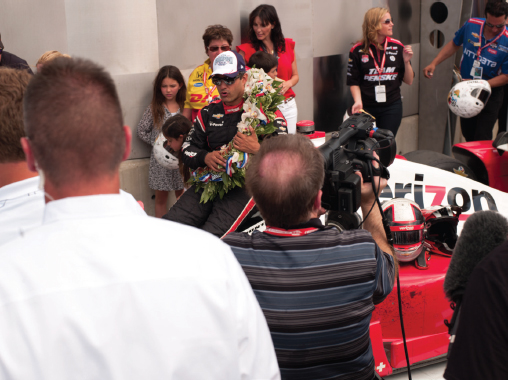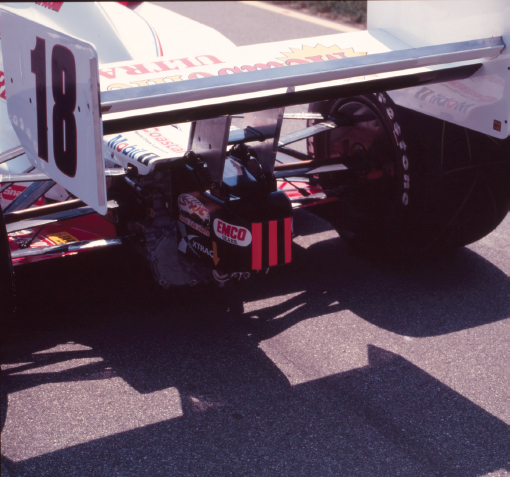
8
DRIVERS

RACING CHAMPIONS frequently stay involved with the sport after hanging up their racing shoes. Mentoring the next crop of drivers is something that adds zest to the sport. Not every past winner has the eye to identify and the disposition to develop the next top driver, but many do it quite successfully. In some cases, these “teachers” might serve as a team owner (such as A. J. Foyt) or as a “driver development” coach for individuals, race teams, or the Indy Racing League. Young drivers can now “learn the trade” from past Indy 500 winners with names like Mario Andretti, A. J. Foyt, Al Unser, Bobby Rahal, Parnelli Jones, Danny Sullivan, Dario Franchitti, Gil De Ferran, Eddie Cheever, Johnny Rutherford, Rick Mears, or Arie Luyendyk.
The driver’s world during a race can be a lonely, solo effort—much like championship golf, tennis, or boxing. Pressure to succeed can be intense, knowing that the world is watching individual performance “in real time.” Having the guidance (frequently in the driver’s earpiece) of one who has succeeded in similar circumstances can be a valuable tool.
Clearly, racers are a breed apart. They speak of the joy they experience when they match their driving mastery and their well-balanced machine against like-minded competitors. The rest of us are puzzled and amazed at their passion and skill.
They’ve won with go-carts, formula racers, motorcycles, sprint cars—on ovals, road courses, and hill climbs—and have a wall full of sparkling trophies to show for it.

Juan Pablo Montoya, winner of the 2015 Indy 500.

These small computer “thumb storage drives” are labeled with individual drivers’ data. They were located in proximity to safety and “accident recorder” equipment, so it’s thought they may hold medical information such as blood type and drug allergy.

Rookie Stripes:
The three vertical stripes here on the “impact attenuator” (crush box) mounted behind the transmission give drivers who are overtaking a slower vehicle a heads up: Caution! This is his first year out here!
|
Q&A WITH LYN ST. JAMES VETERAN INDY DRIVER, ON TRAINING AND FITNESS |
 |
I spoke with the 1992 Rookie of the Year on Race Day, 2014.
Q: WHAT CAN DRIVERS DO TO PREPARE FOR RACING AT THIS LEVEL OF COMPETITION?
It’s really both physical and mental. You really divide them.
When you’re training, the “physical” is more about endurance. So it’s “enduring strength,” it’s “enduring cardiovascular.”
The way I explain what it’s like to drive a race car, like an IndyCar:
Put on a warm-up suit and get on an exercise bike. You should have a helmet on. No iPod, no music. You’re not looking for something to relax you or distract you. Take two ten-pound weights and put them in front of you. Start pedaling and get your heart rate up to about 85 percent of your “max.” That’s what we maintain the entire time we’re in the car. They’ve actually fitted heart monitors on hundreds of race car drivers to confirm this.
Taking your two ten-pound weights, look straight ahead and focus on something that you put in your line of sight. Turn those weights as if you’re steering a race car. If it’s a road course, you go both right and left. You have nothing to rest your arms on—no elbow rests or anything. You do that while someone with a ball-peen hammer is beating lightly on your body, simulating the vibration and energy you are absorbing in the car. This is what’s happening all throughout your body; especially through the legs and torso and even through your arms, you’re feeling that while you’re holding the wheel.
You do that for forty-five minutes or so. That’s kind of “the experience.” As you’re doing all of that, you have to make . . . split second decisions. It’s a bit hard to simulate that, but you can do it.
So how do you prepare yourself to do that without draining yourself physically and mentally? You do that by those forty-five-minute or one-hour cardiovascular routines. You also have to lift weights. You look for the maximum you can lift for an extended period of time. It’s an “endurance” thing rather than your muscle-bound stuff. Physically you have to train so that your body is prepared for the environment you’re going to be in. And mentally—that’s the harder part—to concentrate and to train yourself mentally, to not get physically drained when you have to concentrate for long periods of time.
I became aware back in 1988 or 1989 of a group at McGill University that had created a training protocol; included in that system they eventually developed a software program called Mind Shape. It was about long-term memory and short-term memory. It’s not a “game,” but it’s kind of like a game in the sense that you have different curricula . . . on the computer screen. You keep track of your scores. You can store your performances in a database. If you wish, you can compete with some of the other people. You don’t know who they are, so in that sense it’s a little like a game if you want to use it that way. There were different settings for short-term memory or long-term. In one exercise they would flash five numbers on the screen and then they’d go away. Then they would ask: could you remember those? It really helps in exercising our mind and our brain.
They also had another deal—a big “light board.” Jim Leo has one at PitFit here in Indianapolis. You stand there and focus on the red light in the middle. The lights flash, and you have to hit the exact one that’s lit. You time this. It’s “reaction time” and “anticipatory reaction time” that you’re measuring. There, visually, you can exercise your eyes. You’re looking peripherally. You don’t really turn your head, because you don’t turn your head much in the car.
You’re training both your mind and your eyes. It’s really the most important thing to have, for top performance when you’re at 235 or 240 going down the straightaway getting ready to go into the corner at 220. Physically and mentally, it’s draining and demanding.
More muscle doesn’t make you go fast. You don’t “muscle” the car around. You have to be very precise.
Q: ARE THE DRIVERS ON THE STARTING GRID TODAY EXCEPTIONAL “1 IN 100” ATHLETES?
Absolutely!
I think so. If you look at them, they are. Look at the leanness. Leanness is critically important. If you have too much fat around your muscles then you “overheat” sooner. That’s the biggest problem with that. Fat “insulates” muscle. What you want to do is be able to dissipate heat. You can do that when you develop a leaner body.
The training and conditioning required is really hard. I was never a great athlete. I can’t run really well. I’m not physically the kind of athlete that’s going to play baseball or football. However, there are “athletes in their minds” as well as “athletic bodies.” It’s a different execution of the word “athlete.”
